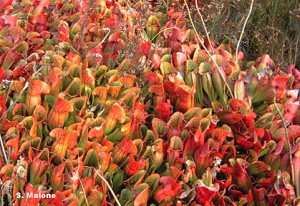Peatland as a potential habitat for colonisation by invasive species is restricted due to its characteristics. The high moisture content of the peat soil promotes a very acidic substrate, of low nutritional value which acts as a natural control for many invasive species. However if this habitat is altered, particularly by human activity such as drainage, it becomes a highly suitable environment for rapid colonisation by certain invasive species. To date, the main species that have caused problems for peatland conservation include Rhododendron (Rhododendron ponticum), Pitcher plant (Sarracenia purpurea) and a number of conifer species. Both Rhododendron and Pitcher plant can exclude the native bogland flora by competing for space. Once established both species can spread quickly. Conifer trees that become established on a bog surface have the additional effects of causing drying out and increased shading which transforms the bog surface into an unsuitable habitat for peatland flora, and ultimately creates conditions suitable for woodland. Boggy ground which has been reclaimed for agricultural purposes and subsequently abandoned provides an ideal habitat for Gunnera tinctoria. This species has become a particular problem on Achill Island, Co. Mayo.
 The table below shows the number of peatland sites of conservation importance that are known to be impacted by invasive plant species. IPCC’s sites database indicates that 84 conservation worthy peatland sites are affected by alien species. The overall trend is likely to be an increase in invasive species on peatlands, in part as a result of the on-going drying out process caused by drainage associated with turf cutting and the spreading of pines from adjacent plantations. A survey by Fernandez et al, (2005) found invasive species on 35 out of 48 raised bogs surveyed in the Irish midlands. The most common invasive species surveyed were Pinus contorta, Rhododendron ponticum and Sarracenia purpurea (shown in the photograph inset).
The table below shows the number of peatland sites of conservation importance that are known to be impacted by invasive plant species. IPCC’s sites database indicates that 84 conservation worthy peatland sites are affected by alien species. The overall trend is likely to be an increase in invasive species on peatlands, in part as a result of the on-going drying out process caused by drainage associated with turf cutting and the spreading of pines from adjacent plantations. A survey by Fernandez et al, (2005) found invasive species on 35 out of 48 raised bogs surveyed in the Irish midlands. The most common invasive species surveyed were Pinus contorta, Rhododendron ponticum and Sarracenia purpurea (shown in the photograph inset).
The table shows the number of conservation worthy peatlands in the Republic of Ireland threatened by invasive species. Source: IPCC’S Peatland Sites Database 2009.
| Invasive Species | Fen | Raised Bog | Blanket Bog |
| Gunnera tinctoria | – | – | 3 |
| Picea abies | 1 | – | – |
| Picea sitchensis | 3 | 6 | 1 |
| Pinus contorta | – | 5 | 1 |
| Pinus sylvestris | 9 | 29 | – |
| Sarracenia purpurea | 2 | 8 | 1 |
| Sarracenia flava | – | 1 | – |
| Rhododendron ponticum | 10 | 7 | 10 |
The priority actions for tackling the issue of invasive species on peatlands in the Republic of Ireland are set out in the table below:
| Actions Needed to Control Invasive Species on Peatlands |
Priority | Timescale On-going Short (0-3 years) Medium (3-5 years) Long (5-10 years) |
| Take an all Ireland approach to controlling invasive species on peatlands. | High | On-going |
| Incorporate measures for the eradication of alien plant species in all peatland management. | High | Medium |
| Assess the ecological and economic impact of invasive species in Ireland in order to plan and execute cost-effective strategies for their control and eradication. | Medium | Medium |
| Raise awareness through education and public awareness programmes of the effects of invasive species on our natural environment. In particular attention should be drawn to preventing spread and the means of control. | High | Long |
| Incorporate measures for the prevention and eradication of invasive species into agri-environment schemes and into Local Biodiversity Action Plans. | High | Medium |
| Use only native flora in all publicly funded planting including infrastructure projects and in public places. | High | On-going |
| Ban the sale of known invasive plant species such as Gunnera tinctoria and Rhododendron ponticum for horticultural purposes nationwide. | High | Short |
| Determine the distribution of established invasive species on peatlands and monitor their expansion. | Medium | Medium |
| Report all sightings of invasive species to Invasive Species Ireland. | High | On-going |
| Prevent the spread and new introduction of invasive species through collaboration with government, academic, NGO and industry groups. | High | On-going |
| Provide an early warning system to notify site managers of range expansion or new introductions of invasive species. | High | Short |
Source Citation
Malone, S. and O’Connell, C. (2009) Ireland’s Peatland Conservation Action Plan 2020 – halting the loss of peatland biodiversity. Irish Peatland Conservation Council, Kildare.
Expanding on the Content of the IPCC Action Plan 2020
Please follow the links below to further information from the IPCC Action Plan 2020.
Purchase
Copies of Ireland’s Peatland Conservation Action Plan 2020 – halting the loss of peatland biodiversity cost €25 and may be ordered from the Nature Shop
Text, Photographs and Images © Irish Peatland Conservation Council, Bog of Allen Nature Centre, Lullymore, Rathangan, Co. Kildare. Email: bogs@ipcc.ie; Tel: +353-45-860133.
